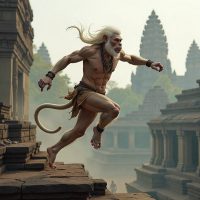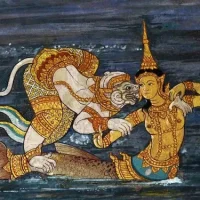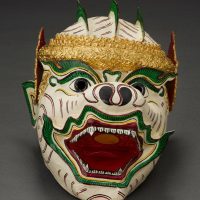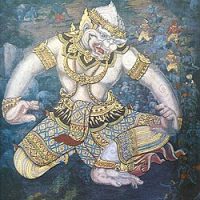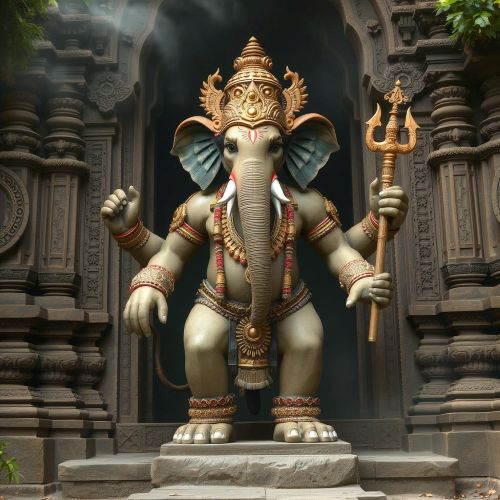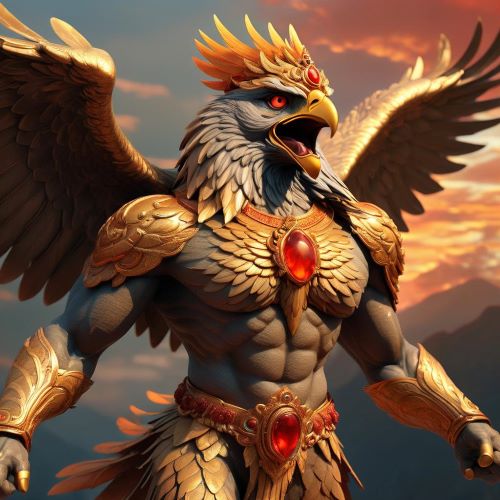Hanuman : The White Monkey God of Cambodia’s Reamker Epic
Listen
At a glance
| Description | |
|---|---|
| Origin | Cambodian Mythology |
| Classification | Hybrids |
| Family Members | Suvannamaccha (Wife), Macchanu (Son) |
| Region | Cambodian |
| Associated With | Warrior, Shapeshifting |
Hanuman
Introduction
Hanuman, one of the most celebrated figures in Hindu mythology, holds an equally revered place in Cambodian cultural tradition through the Reamker, the Khmer adaptation of the Ramayana. As the devoted companion of Preah Ream (Rama), Hanuman becomes a bridge between Indian mythology and Southeast Asian storytelling, embodying the ideals of steadfast loyalty, courage, intelligence, and spiritual dedication. Cambodia’s retelling of his adventures is not a mere translation but a cultural transformation, weaving local aesthetics, moral values, and artistic traditions into the larger Ramayana framework. His character becomes a symbol of bravery and devotion, and his presence in Cambodian mythology highlights centuries of cultural exchange and shared narratives across Asia.
Physical Traits
In Cambodian mythology, Hanuman is portrayed as a striking white monkey warrior whose form blends animal and human characteristics in perfect balance. His muscular build expresses exceptional strength, while his upright posture and expressive features reflect intelligence and discipline. Traditional Khmer dance-dramas, such as Lakhon Khol and the Royal Ballet, depict Hanuman through intricately crafted masks, shimmering costumes, and elaborate crowns that emphasize his divine and heroic nature. His long white tail and energetic poses—often mid-leap or in battle stances—symbolize his supernatural agility, speed, and ability to traverse great distances. Temple art, especially in Angkor Wat and other ancient Khmer sites, captures Hanuman in active, dynamic panels that reinforce his role as a tireless warrior with unmatched vitality and purpose.
Family
Hanuman’s lineage in Cambodian mythology remains closely aligned with the Indian tradition while incorporating Southeast Asian storytelling elements. He is the son of the wind god Vayu and the celestial nymph Anjana, a heritage that bestows him with breathtaking speed, resilience, and divine protection. Cambodian retellings, however, expand his familial associations through unique regional stories. One of the most significant is his encounter with Suvannamaccha, the golden mermaid princess and daughter of Reap (Ravana). Their union, prominent in Southeast Asian versions of the epic, leads to the birth of Macchanu, a monkey-merman warrior capable of navigating land and sea. This addition enriches Hanuman’s narrative in Cambodia, revealing a softer, romantic dimension while maintaining his primary identity as Preah Ream’s loyal general and spiritual devotee.
Other names
Although “Hanuman” remains his primary name in Cambodia, the Khmer tradition also recognizes him through titles that elevate his royal and divine stature. “Preah Hanuman”—meaning “Holy” or “Revered Hanuman”—is commonly used in classical performances and literary works. In surrounding Southeast Asian cultures, where his story overlaps with Cambodian mythology, he appears in forms such as Hunlaman (Lao), Hanoman (Indonesia), and Andoman (Malay), demonstrating the widespread adaptation of his character across the region. Some of his pan-Asian titles, including Mahavira (the valiant one) and Mahakaya (the mighty body), highlight attributes that are universally associated with Hanuman’s mythological role.
Powers and Abilities
Hanuman’s powers define him as one of the most extraordinary beings in the Reamker. His supernatural strength allows him to overpower giants and demons, while his ability to leap across oceans underscores his unmatched agility. Cambodian adaptations emphasize his shapeshifting abilities, portraying him as a figure who can grow into a towering giant to intimidate enemies or shrink to a tiny form to infiltrate secret spaces. His power of flight, inherited from his divine father, enables him to travel swiftly between realms. Hanuman’s strategic brilliance is equally important—he uses disguises, intelligence, and psychological warfare to outwit adversaries and gather vital information for Preah Ream. In many Cambodian stories, Hanuman is immune to fire, sorcery, and weapons, making him nearly invincible. His devotion to Preah Ream remains the source of his greatest strength, reinforcing themes of loyalty and righteousness.
Modern Day Influence
Hanuman remains deeply embedded in contemporary Cambodian culture. The Reamker continues to be performed at royal ceremonies, festivals, and cultural events, with Hanuman often receiving the most dynamic, acrobatic, and visually engaging roles. His movements—playful, daring, and heroic—are central to the storytelling style of Khmer classical arts. In temple bas-reliefs, especially within the Angkor Wat complex, Hanuman appears in scenes of battle, devotion, and strategic triumph, reflecting his enduring symbolic power. Cambodian artisans frequently carve Hanuman into wood, stone, and metal objects used for decoration, spiritual protection, and cultural preservation. In modern media, Hanuman’s presence extends into comics, animations, school curricula, and national folklore education, keeping his legacy alive for younger generations. Today, he stands not only as a mythological hero but also as a cultural icon representing strength, loyalty, and resilience in the Cambodian imagination.
Related Images
Source
Hanuman. (2002, October 5). In Wikipedia. https://en.wikipedia.org/wiki/Hanuman
WEPA: World Encyclopedia of Puppetry Arts. Hanuman. https://wepa.unima.org/en/hanuman/
Rajendran, A. (2024). Hanuman in Ramayana in Cambodia. Hindu Blog. https://www.hindu-blog.com/2024/10/hanuman-in-ramayana-in-cambodia.html
Know Your Epics. (n.d.). Hanuman’s Presence in Southeast Asian Mythology: Divine Influence. https://knowyourepics.com/hanumans-presence-in-southeast-asian-mythology-divine-influence
Wikipedia contributors. (2024). Suvannamaccha. Wikipedia. https://en.wikipedia.org/wiki/Suvannamaccha
Cravath, P. (1985). Earth in Flower: The Divine Mystery of the Cambodian Dance Drama. DatAsia Press.
Brandon, J. R. (1967). Theatre in Southeast Asia. Harvard University Press.
Pou, S. (1992). Ramayana in Southeast Asia: A Comparative Study. Journal of the Siam Society, 80(1), 45–58.
Groslier, B. P. (1968). Angkor and Cambodia in the Sixteenth Century. Oxford University Press.
Jacob, H. (2007). The Reamker: The Cambodian Ramayana. In Asian Theatre Journal, 24(2), 200–225.
Frequently Asked Questions
Who is Hanuman in Cambodian mythology?
Hanuman in Cambodian mythology is a central hero of the Reamker, the Khmer version of the Ramayana, known for his loyalty, strength, and divine powers.
How is Hanuman depicted in Cambodia?
Hanuman is portrayed as a white monkey warrior with a muscular humanoid body, often shown in ornate Khmer costumes in dance-drama performances.
Does Hanuman have a family in Cambodian stories?
Yes, Cambodian versions include his relationship with Suvannamaccha and introduce their son Macchanu, expanding his family beyond the Indian tradition.
What powers does Hanuman have in the Reamker?
He can fly, shapeshift, grow or shrink in size, fight demons, withstand fire, and use clever strategies to aid Preah Ream.
How is Hanuman represented in modern Cambodian culture?
He remains a prominent figure in classical dance, temple carvings, literature, and modern media, symbolizing courage, loyalty, and cultural pride.


